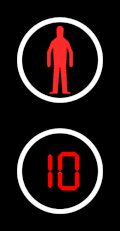Traffic light
Traffic lights (or traffic signals or stoplights) are lights used to control the movement of traffic. They are placed at road intersections and crossings.[1] The different colours of lights tell drivers what to do.
In South Africa, they call them robots.[2][3]
In Japan, the green light is also blue because ao in Japanese means green and blue.[4]
Light cycles
Traffic lights change their colours in the same order every time. In most English-speaking countries, traffic lights usually change in this order:
- Red light on: This tells drivers to stop.
- Green light on: This tells drivers to start or keep driving.
- Yellow light on: This tells drivers to drive slowly.
Lester Wire was credited with the invention of the electric traffic light in 1912 in Salt Lake City, Utah.[5] Garrett Morgan, an African-American inventor, also developed a traffic signalling system, and was one of the first people to get a patent for a traffic light.[6]
William Potts, a Detroit police officer, invented the first traffic light with three colours in 1920 in Detroit, Michigan.[7]
Traffic Light Media
An LED 50-watt traffic light in Portsmouth, United Kingdom
Road crossing of A970 with Sumburgh Airport's runway in Shetland. The movable barrier closes when an aircraft lands or takes off.
References
- ↑ "Frequently Asked Questions - Traffic Signals". FDOT. Retrieved 13 April 2021.
- ↑ "robot – definition of robot in English – Oxford Dictionaries". Oxford Dictionaries – English. Archived from the original on 14 August 2018.
- ↑ "see robot – definition of robot in Dictionary of South African English". Editor's Note: The origin of 'robot' used as 'traffic light' is from the English translation of the play R.U.R. by Karel Čapek which debuted in England in 1923 which introduced the term 'robot' to an English audience. For a short time in England it was fashionable to use 'robot' for 'traffic light' from the late 1920s, when traffic lights were being installed in England. This usage travelled to South Africa in the early 1930s, when they had their first traffic lights installed, and where it continues to be used almost 90 years later, while 'robot' for 'traffic light' fell out of usage in England. See Foster, B. 1970. The changing English language. Harmondsworth, Middlesex: Penguin.
- ↑ Backhaus, Peter (25 February 2013). "The Japanese traffic light blues: Stop on red, go on what?". The Japan Times. Retrieved 9 September 2024.
- ↑ Bellis, Mary (5 February 1952). "The History of Roads and Asphalt". theinventors.org.
- ↑ "US Patent: US1475024A 'Traffic signal' (1923)". Google.
- ↑ Moyer, Sheldon (March 1947). "Mr. 'Trafficlight'". Motor News. Archived from the original on 13 September 2023 – via large.stanford.edu.
Other websites
| Wikimedia Commons has media related to: |
- FHWA Arterial Management Website, latest information on traffic signal operations
- Animations of various US signal phasings Archived 17 May 2013 at the Wayback Machine
- SCATS – Sydney Coordinated Adaptive Traffic System
- Safety Evaluation of Converting Traffic Signals from Incandescent to Light-emitting Diodes: Summary Report Federal Highway Administration
- Safety Evaluation of Discontinuing Late-night Flash Operations at Signalized Intersections: Summary Report Federal Highway Administration
- Traffic signals, 1922, digitized NYPD photograph from the Lloyd Sealy Library Digital Collections









